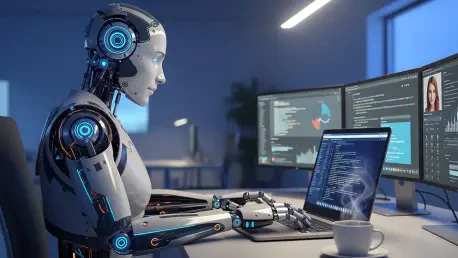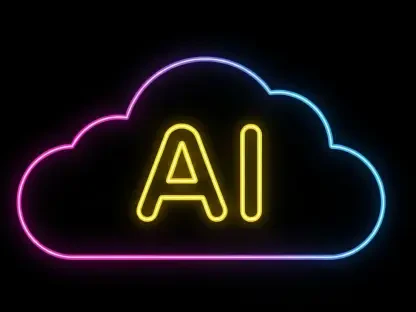In an era where artificial intelligence (AI) is fundamentally transforming software development, the integration of generative AI models and coding assistants into everyday workflows has become both a boon and a challenge, promising unprecedented efficiency by automating complex tasks and accelerating project timelines. However, beneath the surface of this technological revolution lies a persistent issue: a profound trust gap. Many developers and stakeholders remain skeptical about the reliability of AI-generated outputs, often citing frequent inaccuracies and the necessity for constant human intervention. This skepticism creates a barrier to fully embracing AI’s potential. Addressing this gap is not just about improving technology but also about rethinking roles, responsibilities, and strategies within development teams. By exploring the root causes of distrust and identifying actionable solutions, the path to a more harmonious integration of AI in software creation becomes clearer, paving the way for innovation without compromising quality.
Unpacking the Rise and Skepticism of AI Tools
The adoption of AI tools in software development has surged dramatically, with a recent Stack Overflow Developer Survey revealing that 84% of developers are either using or planning to use these technologies in their workflows. This widespread embrace signals a recognition of AI’s capacity to enhance productivity and streamline processes. Yet, despite this enthusiasm, trust remains a significant hurdle. Only 33% of developers express confidence in the accuracy of AI outputs, highlighting a stark disconnect. This lack of faith often stems from experiences with inconsistent results that fail to meet expectations. The tension between adoption and skepticism is a critical barrier, as it impacts not only individual projects but also the broader perception of AI as a reliable partner in development. Understanding the nuances of this distrust is the first step toward crafting strategies that can align technological advancements with user confidence.
Moreover, the implications of this trust gap extend beyond mere numbers. For many development teams, the hesitation to fully rely on AI tools translates into slower integration and missed opportunities for innovation. Engineering leaders frequently report that the promise of efficiency is undermined by the need for extensive oversight to catch errors or refine outputs. This creates a cycle where potential time savings are offset by the effort required to ensure quality. Addressing this issue demands a deeper look into why AI outputs often fall short and how human expertise can be positioned to complement rather than merely correct these tools. By identifying specific pain points, such as the frequency of bugs or misaligned code, stakeholders can begin to develop targeted solutions that bolster trust without sacrificing the benefits AI brings to the table.
Confronting the “Almost Right” Challenge
One of the most pervasive issues with AI in development is the phenomenon of outputs being “almost right, but not quite,” as noted by 66% of developers in recent surveys. This near-accuracy might seem like a minor inconvenience, but it creates a significant hidden burden on productivity. Developers often find themselves spending considerable time debugging and refining AI-generated code to make it functional for real-world applications. This iterative process can erode the very efficiency that AI tools are meant to deliver, turning a potential asset into a source of frustration. The challenge lies in transforming these rough drafts into polished, reliable solutions without draining resources, a task that requires both technical finesse and strategic planning.
Additionally, the prevalence of bugs introduced by AI tools compounds this dilemma, with 60% of engineering leaders reporting issues in at least half of their projects. These errors range from minor glitches to critical flaws that could compromise entire systems if left unchecked. The necessity for meticulous human oversight becomes evident, as automated systems alone cannot address the nuanced demands of specific projects or business contexts. This reality underscores a broader need for robust validation processes that can catch and correct AI missteps early on. By implementing structured review mechanisms and fostering a culture of vigilance, development teams can mitigate the risks associated with near-right outputs, ensuring that AI serves as a helpful tool rather than a liability.
Redefining Developer Roles in the AI Era
As AI tools become more embedded in software development, the role of developers is undergoing a profound transformation. No longer confined to simply writing code, developers now often act as supervisors and validators, tasked with overseeing AI-generated outputs to ensure they meet required standards. In many cases, the time spent reviewing and refining these outputs rivals the effort put into original coding. This shift is particularly pronounced in high-stakes environments like enterprise settings, where errors can have far-reaching consequences. Positioning developers as the final checkpoint for quality highlights their critical role in narrowing the trust gap and ensuring that AI contributions align with project goals.
Beyond oversight, developers are increasingly seen as orchestrators who integrate AI outputs with system-specific knowledge and business logic that these tools often lack. This expanded responsibility requires a blend of technical expertise and strategic insight, as they must anticipate potential pitfalls and guide AI toward meaningful results. The evolving nature of their work emphasizes the importance of adaptability in an industry reshaped by automation. Equipping developers with the skills to navigate this dual role—part creator, part guardian—becomes essential for maintaining the integrity of software projects. Through this lens, their contribution is not just about fixing errors but about shaping AI’s role as a reliable partner in development.
Harnessing Collaboration Across Disciplines
AI-driven development is far from a solitary pursuit; it thrives on the collaboration of diverse professionals who each bring unique perspectives to the table. Beyond developers, roles such as data scientists, product managers, UX designers, and quality assurance teams are integral to building trust in AI outputs. Data scientists focus on refining the models that power AI tools, ensuring accuracy and implementing necessary guardrails. Meanwhile, product managers and UX designers shape how users interact with AI features, prioritizing intuitive and trustworthy experiences. Other teams, including those in security and operations, safeguard against vulnerabilities that could undermine confidence. This interdisciplinary approach reflects the complexity of modern software projects and the shared responsibility for reliability.
The synergy of these roles creates a robust ecosystem where trust is built through collective effort. For instance, while a developer might validate the technical accuracy of AI-generated code, a product manager ensures it aligns with user needs, and a security specialist checks for potential risks. This interconnectedness prevents oversight gaps and fosters a holistic approach to quality assurance. Clear communication and defined responsibilities among team members are vital to avoid duplication of effort or neglected areas. By leveraging the strengths of each discipline, organizations can address the multifaceted challenges of AI integration, ensuring that no single aspect—be it technical, user-facing, or operational—is overlooked in the quest to close the trust gap.
Prioritizing Human Oversight in AI Integration
A fundamental principle in bridging the trust gap is the recognition that AI should augment, rather than replace, human expertise. Keeping humans in the loop through checks and balances like automated testing and manual code reviews is crucial for catching errors that AI might miss. These processes act as a safety net, ensuring that outputs are not only functional but also aligned with specific project requirements. Equally important is the establishment of clear role definitions within teams to prevent accountability gaps. When responsibilities are well-articulated, the risk of errors slipping through unnoticed diminishes, fostering a culture of reliability and trust in AI-driven workflows.
Furthermore, a human-centric approach to AI integration acknowledges the limitations of technology in understanding nuanced contexts or making critical judgment calls. In scenarios where stakes are high, such as in enterprise applications, human intervention becomes indispensable to address issues that automated systems cannot fully grasp. This balance between leveraging AI’s efficiency and maintaining human oversight ensures that technology serves as a supportive tool rather than an autonomous decision-maker. By embedding these principles into development practices, organizations can mitigate the risks associated with over-reliance on AI, creating a framework where innovation and accountability coexist seamlessly.
Investing in Skills to Build Confidence
The success of AI tools in software development hinges significantly on the capabilities of the individuals using them. Data from Stack Overflow indicates a striking difference in perception based on usage frequency: developers engaging with AI daily report an 88% favorability rate, compared to just 64% among weekly users. This disparity suggests that familiarity, underpinned by proper training, plays a pivotal role in enhancing trust and effectiveness. Organizations must prioritize upskilling their teams to navigate the complexities of AI, ensuring that professionals are equipped to maximize the benefits of these tools while minimizing potential pitfalls.
Beyond basic familiarity, targeted training programs can empower developers and other stakeholders to discern when to trust AI outputs and when to intervene. This includes understanding the strengths and weaknesses of specific tools, as well as mastering complementary skills like debugging and system integration. Such investments not only improve individual competence but also contribute to a broader culture of confidence within teams. When professionals feel prepared to handle AI’s nuances, skepticism gives way to constructive collaboration. Emphasizing continuous learning as a cornerstone of AI adoption ensures that the workforce remains agile in an ever-evolving technological landscape, ultimately strengthening trust in these transformative tools.
Charting a Path Forward with Balanced Perspectives
Reflecting on the journey to integrate AI into software development, it becomes evident that while the technology offers remarkable potential for efficiency, persistent challenges like inaccuracies and bugs demand careful navigation. The trust gap, once a formidable barrier, can be addressed through a concerted effort to redefine roles, with developers emerging as guardians of quality who meticulously refine AI outputs. Collaboration across disciplines plays a pivotal role, as diverse teams contribute unique expertise to ensure reliability at every stage. Human oversight, supported by structured checks and training, proves indispensable in mitigating risks.
Looking ahead, the focus should shift to actionable strategies that sustain this progress. Organizations must continue to invest in skill development, ensuring that teams remain adept at leveraging AI’s strengths. Establishing standardized protocols for validation and accountability can further solidify trust, creating a seamless partnership between humans and technology. By maintaining a cautious yet optimistic stance, the industry can harness AI as a powerful ally, driving innovation while safeguarding quality. This balanced approach offers a blueprint for future advancements, ensuring that the trust gap narrows with each step forward.









